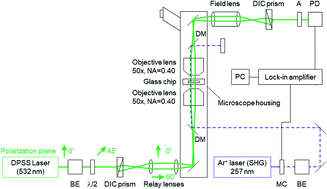Our official English website, www.x-mol.net, welcomes your
feedback! (Note: you will need to create a separate account there.)
Ultrasensitive detection of nonlabelled bovine serum albumin using photothermal optical phase shift detection with UV excitation
Analyst ( IF 3.6 ) Pub Date : 2020/03/09 , DOI: 10.1039/d0an00037j Hisashi Shimizu 1, 2, 3, 4 , Shigenori Takeda 2, 4, 5, 6, 7 , Kazuma Mawatari 2, 4, 5, 6, 7 , Takehiko Kitamori 2, 4, 5, 6, 7
Analyst ( IF 3.6 ) Pub Date : 2020/03/09 , DOI: 10.1039/d0an00037j Hisashi Shimizu 1, 2, 3, 4 , Shigenori Takeda 2, 4, 5, 6, 7 , Kazuma Mawatari 2, 4, 5, 6, 7 , Takehiko Kitamori 2, 4, 5, 6, 7
Affiliation

|
Ultrasensitive detection of nonlabelled bovine serum albumin is performed in micro/nanofluidic chips using a photothermal optical phase shift (POPS) detection system. Currently, micro- and nanofluidics allow the analysis of various single cells, and their targets of interest are shifting from nucleic acids to proteins. Previously, our group developed photothermal detection techniques for the sensitive detection of nonfluorescent molecules. For example, we developed a thermal lens microscope (TLM) with ultrahigh sensitivity at the single-molecule level and a POPS detector that is applicable to nanochannels smaller than the wavelength of light. The POPS detector also realized the detection of nonlabelled proteins in nanochannels, although its detection sensitivity is less than that of the TLM in microchannels due to insufficient background light reduction. To overcome this problem, we developed a new POPS detector using relay optics for further reduction of the background light. In addition, heat transfer from the sample solution to the nanochannel wall was thoroughly investigated to achieve ultrahigh sensitivity. The limit of detection (LOD) obtained with the new POPS detector is 30 molecules in 1.0 fL. Considering this LOD, the performance of the new POPS detector is comparable with that of the TLM. Owing to the applicability of the POPS detector for sensitive detection even in nanochannels or single-μm channels, which cannot be realized with the TLM, combinations of the POPS detector and separation techniques employing unique nanochannel properties will contribute to advances in single-cell proteomics in the future.
中文翻译:

紫外激发光热光学相移检测超灵敏检测未标记牛血清白蛋白
使用光热光学相移(POPS)检测系统在微/纳流控芯片中对未标记的牛血清白蛋白进行超灵敏检测。当前,微流体和纳流体技术允许分析各种单细胞,并且它们感兴趣的靶标正在从核酸转移到蛋白质。以前,我们的小组开发了光热检测技术来灵敏地检测非荧光分子。例如,我们开发了在单分子水平具有超高灵敏度的热透镜显微镜(TLM)和POPS检测器,该检测器适用于小于光波长的纳米通道。POPS检测器还实现了纳米通道中非标记蛋白的检测,尽管由于背景光衰减不足,其检测灵敏度在微通道中低于TLM。为了克服这个问题,我们开发了一种新的POPS检测器,它使用中继光学器件来进一步减少背景光。此外,彻底研究了从样品溶液到纳米通道壁的传热,以实现超高灵敏度。使用新的POPS检测器获得的检测限(LOD)为1.0 fL中的30个分子。考虑到此LOD,新的POPS检测器的性能可与TLM媲美。由于POPS检测器适用于灵敏检测,即使在纳米通道或单微米通道中,TLM也无法实现,
更新日期:2020-03-31
中文翻译:

紫外激发光热光学相移检测超灵敏检测未标记牛血清白蛋白
使用光热光学相移(POPS)检测系统在微/纳流控芯片中对未标记的牛血清白蛋白进行超灵敏检测。当前,微流体和纳流体技术允许分析各种单细胞,并且它们感兴趣的靶标正在从核酸转移到蛋白质。以前,我们的小组开发了光热检测技术来灵敏地检测非荧光分子。例如,我们开发了在单分子水平具有超高灵敏度的热透镜显微镜(TLM)和POPS检测器,该检测器适用于小于光波长的纳米通道。POPS检测器还实现了纳米通道中非标记蛋白的检测,尽管由于背景光衰减不足,其检测灵敏度在微通道中低于TLM。为了克服这个问题,我们开发了一种新的POPS检测器,它使用中继光学器件来进一步减少背景光。此外,彻底研究了从样品溶液到纳米通道壁的传热,以实现超高灵敏度。使用新的POPS检测器获得的检测限(LOD)为1.0 fL中的30个分子。考虑到此LOD,新的POPS检测器的性能可与TLM媲美。由于POPS检测器适用于灵敏检测,即使在纳米通道或单微米通道中,TLM也无法实现,









































 京公网安备 11010802027423号
京公网安备 11010802027423号